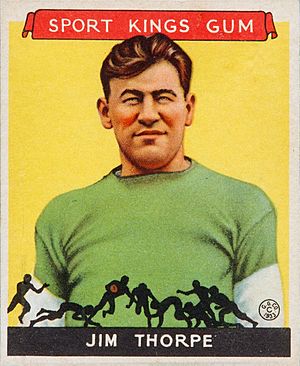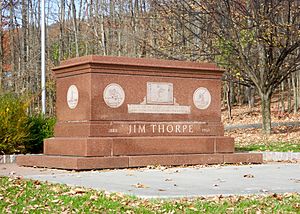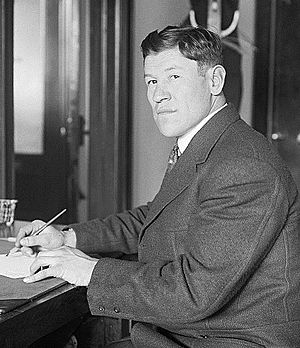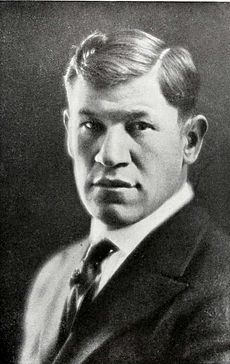Jim Thorpe facts for kids

Thorpe with the Canton Bulldogs, c. 1915 – c. 1920
|
|||
| No. 2, 21, 3 | |||
|---|---|---|---|
| Position: | Running back | ||
| Personal information | |||
| Born: | May 22 or 28, 1887 Near Prague, Indian Territory (in modern Oklahoma, U.S.) |
||
| Died: | March 28, 1953 (aged 65) Lomita, California, U.S. |
||
| Height: | 6 ft 1 in (1.85 m) | ||
| Weight: | 202 lb (92 kg) | ||
| Career information | |||
| College: | Carlisle (1907–1908, 1911–1912) | ||
| Career history | |||
| As player: | |||
|
|||
| As coach: | |||
|
|||
| Career highlights and awards | |||
Baseball career |
|||
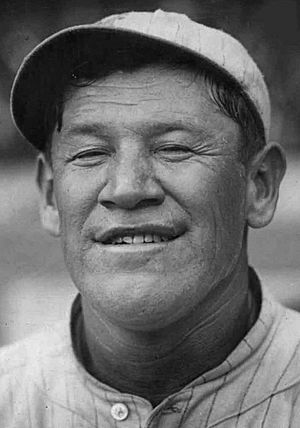
Thorpe as a member of the New York Giants
|
|||
| Outfielder | |||
|
|||
| debut | |||
| April 14, 1913, for the New York Giants | |||
| Last appearance | |||
| September 25, 1919, for the Boston Braves | |||
| MLB statistics | |||
| Batting average | .252 | ||
| Home runs | 7 | ||
| Runs batted in | 82 | ||
| Hits | 176 | ||
| Teams | |||
|
|||
| Career NFL statistics | |||
|
|||
| Head coaching record | |||
| Career: | 14–25–2 | ||
| Player stats at PFR | |||
|
Pro Football Hall of Fame
|
|||
|
College Football Hall of Fame
|
|||
| Olympic medal record | ||
|---|---|---|
| Men's athletics | ||
| Representing the |
||
| Gold | 1912 Stockholm | Decathlon |
| Gold | 1912 Stockholm | Pentathlon |
James Francis Thorpe (May 22 or 28, 1887 – March 28, 1953) was an amazing American athlete. Many people think he was one of the greatest athletes ever. Jim Thorpe won two gold medals at the 1912 Summer Olympics in pentathlon and decathlon. He also played professional football, baseball, and basketball.
He later lost his Olympic titles because he had been paid to play semi-professional baseball before the Olympics. This went against the rules at the time that said Olympic athletes had to be amateurs (not paid). In 1983, 30 years after he died, the International Olympic Committee (IOC) gave his Olympic medals back. They decided the rule about taking away medals had been applied too late.
Jim Thorpe has received many honors for his sports achievements. The Associated Press called him the "greatest athlete" from the first 50 years of the 20th century. A movie about his life, Jim Thorpe – All-American, was made in 1951.
Contents
- Early Life and School
- Football Superstar
- Olympic Glory
- Professional Sports Career
- Controversy and Medals Taken Away
- Restoration of Olympic Medals
- Later Life and Death
- Family Life
- Interesting Facts About Jim Thorpe
- Legacy and Impact
- Jim Thorpe, Pennsylvania
- Achievements
- Key Dates
- Images for kids
- See also
Early Life and School
Jim Thorpe was born on May 22, 1887, near Prague, Oklahoma. His parents had mixed backgrounds, including Sac and Fox and Potawatomi Native American heritage. His Native American name was Wa-Tho-Huk, which means "Bright Path."
Jim went to school at the Sac and Fox Indian Agency with his twin brother, Charlie. When Charlie died from pneumonia at age nine, Jim was very sad. He often ran away from school. His father sent him to the Haskell Institute, a boarding school for Native American children in Lawrence, Kansas.
Two years later, Jim's mother died. He became very sad again and left school to work on a horse ranch. In 1904, at age sixteen, Jim decided to go to the Carlisle Indian Industrial School in Carlisle, Pennsylvania. There, his amazing athletic skills were noticed. He was coached by Glenn Scobey "Pop" Warner, a very famous football coach. Jim's father died that same year, and Jim left school again for a few years before returning to Carlisle.
Football Superstar
Jim Thorpe became a huge football star at Carlisle. He played as a halfback and was known for his incredible speed, quickness, and strength. He was great at running, passing, kicking, and tackling.
One of Jim's most famous football moments was in 1911. He led Carlisle to an amazing 18-15 win over Harvard University, which was one of the best college football teams. Jim scored all of Carlisle's points in that game, showing off his incredible talent. In 1912, he led Carlisle to a perfect season, scoring 198 points!
Olympic Glory
In 1912, Jim Thorpe went to the Olympic Games in Stockholm, Sweden, to represent the United States. He competed in two very tough events: the pentathlon and the decathlon.
- Pentathlon: This event had five parts: running, jumping, wrestling, discus throw, and javelin throw. Jim won four of the five events and earned the gold medal.
- Decathlon: This was an even harder event with ten parts: 100-meter run, long jump, shot put, high jump, 400-meter run, 110-meter hurdles, discus throw, pole vault, javelin throw, and 1500-meter run. Jim won the decathlon with a score of 8,413 points, setting a new world record!
Jim's Olympic wins made him famous around the world. People called him the "world's greatest athlete." King Gustav V of Sweden even told him, "Sir, you are the greatest athlete in the world."
Professional Sports Career
After his Olympic success, Jim Thorpe also won the All-Around Championship of the Amateur Athletic Union. In 1913, he started playing professional baseball for the New York Giants. He played six seasons in Major League Baseball until 1919.
In 1915, Thorpe joined the Canton Bulldogs American football team. He helped them win three championships. He later played for six different teams in the National Football League (NFL). He also played professional basketball with a team made up entirely of Native American players.
From 1920 to 1921, Jim Thorpe was the first president of the American Professional Football Association, which later became the NFL in 1922. He played professional sports until he was 41 years old. His sports career ended around the time the Great Depression began.
Controversy and Medals Taken Away
Sadly, Jim Thorpe's Olympic fame did not last long. In 1913, it was found out that he had played semi-professional baseball for a small amount of money before the Olympics. At that time, Olympic rules said that athletes had to be amateurs, meaning they couldn't be paid for playing sports.
Because of this, the International Olympic Committee (IOC) took away Jim's Olympic medals. They also removed his name from the official Olympic records. Many people thought this decision was unfair because the rules were very strict and Jim might have been treated unfairly.
Restoration of Olympic Medals
In 1982, the IOC finally gave Jim Thorpe's Olympic medals back. This happened after he had passed away. His name was also put back into the Olympic record books. This decision was a big win for everyone who believed that Jim had been treated unfairly for many years.
Later Life and Death
After his sports career ended, Jim Thorpe had a hard time making a living. He worked many different jobs, like being an extra in movies, often playing a Native American chief in Westerns.
He also worked as a construction worker, a bouncer, a security guard, and a ditchdigger. In 1945, during World War II, he briefly joined the United States Merchant Marine. By the early 1950s, Jim Thorpe had run out of money. He spent his last years struggling with poor health and poverty.
Jim Thorpe died on March 28, 1953, when he was 65 years old.
Family Life
Jim Thorpe was married three times and had eight children. His first wife was Iva M. Miller, whom he met at Carlisle. They had four children together. Later, he married Freeda Verona Kirkpatrick, and they had four sons. His third wife was Patricia Gladys Askew, who was with him when he died.
Interesting Facts About Jim Thorpe
- Jim Thorpe was the first Native American to win a gold medal for the United States in the Olympics.
- He was a skilled dancer and won several dance competitions.
- Jim was also a talented singer and played musical instruments.
- He was known for his good sense of humor and making people laugh.
- Thorpe was the last person to compete in both the Olympics (in a non-baseball sport) and Major League Baseball until Eddy Alvarez did it in 2020.
- In 1973, President Richard Nixon declared April 16 as "Jim Thorpe Day" to honor his life.
- The Jim Thorpe Award is given every year to the best defensive back in college football.
- The annual Thorpe Cup athletics meeting is named after him.
Legacy and Impact
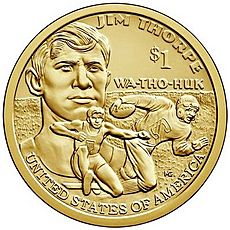
Jim Thorpe's story shows incredible athletic talent, great success, and also sadness. He overcame many challenges and became great in many sports. He achieved his amazing sports feats even though there was a lot of unfairness towards Native Americans in the United States. Some people believe his Olympic medals were taken away because of his Native American background. At the time he won his medals, not all Native Americans were recognized as U.S. citizens. All American Indians were not granted citizenship until 1924.
The Jim Thorpe Area Running Festival, which includes a marathon, started in 2019 in Jim Thorpe, Pennsylvania. The United States Postal Service also put Jim Thorpe on a 32¢ stamp in 1998.
Jim Thorpe, Pennsylvania
After Jim Thorpe's funeral, his body was moved to Pennsylvania. This happened because his third wife heard that two small towns, Mauch Chunk and East Mauch Chunk, wanted to attract more visitors. The towns "bought" Thorpe's remains, built a monument for him, and then merged. They renamed their new united town Jim Thorpe, Pennsylvania in his honor. Jim Thorpe himself had never actually visited this town. The monument has his tomb, two statues of him, and signs telling his life story.
In 2010, Jim Thorpe's son, Jack Thorpe, tried to have his father's remains returned to Oklahoma to be buried near other family members. However, Jack Thorpe passed away in 2011. In 2015, the United States Supreme Court decided not to hear the case, which ended the legal process.
Achievements
- Olympic gold medals in the pentathlon and decathlon (1912)
- College football All-American (1911, 1912)
- Professional baseball player (1913-1919)
- Professional football player (1915-1928)
- Pro Football Hall of Fame inductee (1963)
- National Native American Hall of Fame inductee (2018)
Key Dates
- May 22, 1887: Born near Prague, Oklahoma
- 1904: Enrolls at Carlisle Indian Industrial School
- 1911: Leads Carlisle to victory over Harvard
- 1912: Wins Olympic gold medals in pentathlon and decathlon
- 1913: Stripped of Olympic medals
- 1913-1919: Plays professional baseball
- 1915-1928: Plays professional football
- March 28, 1953: Dies at age 65
- 1982: Olympic medals posthumously restored
Images for kids
-
Thorpe shaking hands with Moses Friedman while Glenn "Pop" Warner (left), Lewis Tewanima (center), and a crowd look on
-
Thorpe in Carlisle Indian Industrial School uniform, c. 1909
See also
 In Spanish: Jim Thorpe para niños
In Spanish: Jim Thorpe para niños




